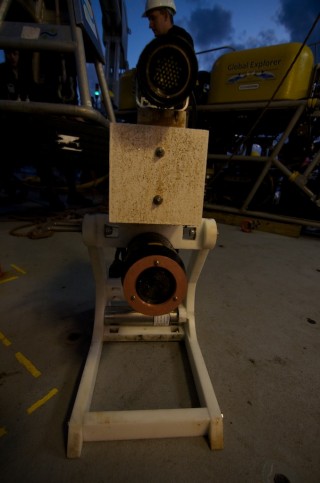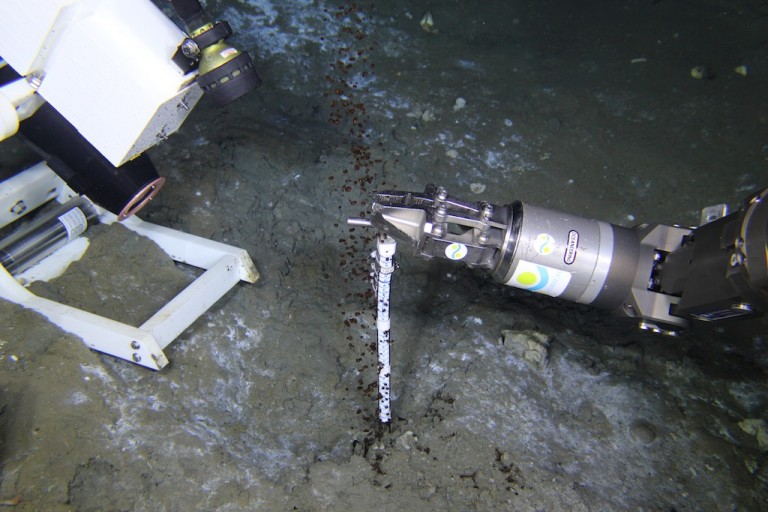Today, the research team completed the final planned ROV dives planned at the natural oil seep site designated as GC600.

ROV Global Explorer MK3 collected more push cores of microbial mats surrounding the seep and the underlying sediment. It also returned to the bubbling seep where the video time-lapse camera (VTLC) system was operating on the seafloor for the past two days. Detailed notes, maps, and navigation systems on the ship as well as reflective markers temporarily put around the site helped the ROV pilots find the instrument.
As ROV Global Explorer MK3 was approaching the seep, the scientists could see that the VTLC light was turning on and off, a sign that the instrument was still working. The plume was still bubbling vigorously in front of the camera lens. Dr. Ian MacDonald directed the ROV pilots to take additional measurements near the plume. The ROV had transported a customized ruler in one of the collection quivers for this purpose. The manipulator arm placed the ruler near the bubbling plume so that both the VTLC and ROV cameras could record the scale of the images that would be part of further analyses. Additional sediment push cores were collected before VLTC was removed from the seep.
ROV operators used the manipulator arm to place VTLC on a hydraulic shelf below the ROV’s main cameras where a customized horizontal bar was constructed to keep it in place. ROV then carried it to R/V Falkor where Dr. Ian MacDonald and his students Caroline Johansen and Mauricio Silva waited in anticipation for the data.
It was just after sunset when the ship’s crane lifted the ROV out of the water. The crew secured the vehicle and the pilots powered down all ROV systems before scientists could get near. Once everything was safe, the scientists could approach the vehicle to offload the samples and gear. There always is a hub of activity around ROV after a dive.

When Ian and Caroline detached VTLC from the shelf, they realized that the once-white instrument was stained brown with oil as a result of spending a coule of days near the natural submarine oil seep. The camera’s light continued to turn on and off as programmed while it sat at on the deck. Ian and Caroline carried the instrument to the R/V Falkor dry lab to download the captured imagery and scan through the time lapce videos to see how the deployment went overall and if there were any notable features of particular interest. They were excited to see that VTLC indeed recorded various interesting dynamics of the plume. Caroline will be analyzing these videos in greater detail as part of her graduate studies.
R/V Falkor left GC600 and headed northeast to the next research site where local deep-sea coral species will be studied. The transit time during the night will be used to collect bathymetric maps of the seafloor targeting the areas for tomorrow’s ROV dives.
